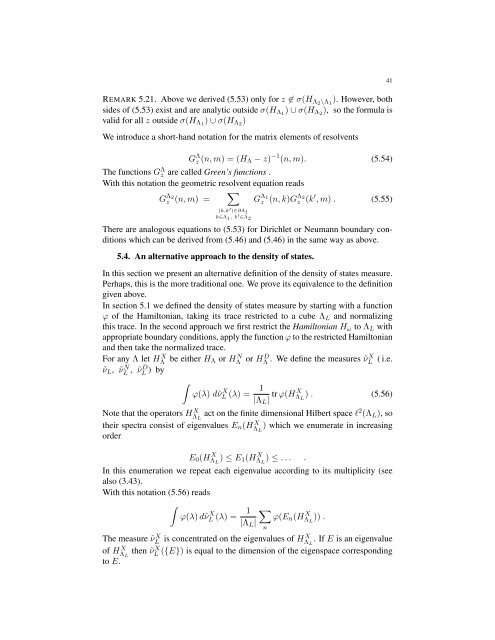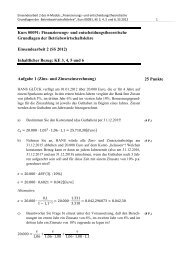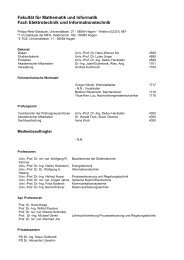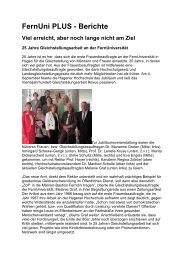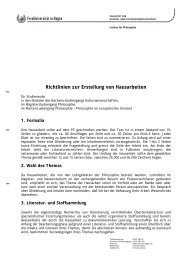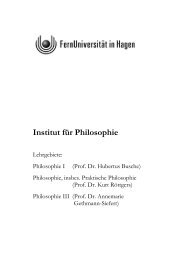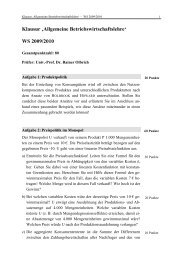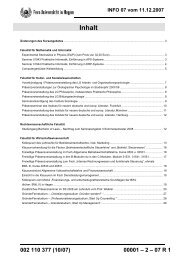An Invitation to Random Schr¨odinger operators - FernUniversität in ...
An Invitation to Random Schr¨odinger operators - FernUniversität in ...
An Invitation to Random Schr¨odinger operators - FernUniversität in ...
Create successful ePaper yourself
Turn your PDF publications into a flip-book with our unique Google optimized e-Paper software.
REMARK 5.21. Above we derived (5.53) only for z ∉ σ(H Λ2 \Λ 1<br />
). However, both<br />
sides of (5.53) exist and are analytic outside σ(H Λ1 ) ∪ σ(H Λ2 ), so the formula is<br />
valid for all z outside σ(H Λ1 ) ∪ σ(H Λ2 )<br />
We <strong>in</strong>troduce a short-hand notation for the matrix elements of resolvents<br />
G Λ z (n, m) = (H Λ − z) −1 (n, m). (5.54)<br />
The functions G Λ z are called Green’s functions .<br />
With this notation the geometric resolvent equation reads<br />
∑<br />
G Λ 2<br />
z (n, m) = G Λ 1<br />
z (n, k)G Λ 2<br />
z (k ′ , m) . (5.55)<br />
(k,k ′ )∈∂Λ 1<br />
k∈Λ 1 , k ′ ∈Λ 2<br />
There are analogous equations <strong>to</strong> (5.53) for Dirichlet or Neumann boundary conditions<br />
which can be derived from (5.46) and (5.46) <strong>in</strong> the same way as above.<br />
5.4. <strong>An</strong> alternative approach <strong>to</strong> the density of states.<br />
In this section we present an alternative def<strong>in</strong>ition of the density of states measure.<br />
Perhaps, this is the more traditional one. We prove its equivalence <strong>to</strong> the def<strong>in</strong>ition<br />
given above.<br />
In section 5.1 we def<strong>in</strong>ed the density of states measure by start<strong>in</strong>g with a function<br />
ϕ of the Hamil<strong>to</strong>nian, tak<strong>in</strong>g its trace restricted <strong>to</strong> a cube Λ L and normaliz<strong>in</strong>g<br />
this trace. In the second approach we first restrict the Hamil<strong>to</strong>nian H ω <strong>to</strong> Λ L with<br />
appropriate boundary conditions, apply the function ϕ <strong>to</strong> the restricted Hamil<strong>to</strong>nian<br />
and then take the normalized trace.<br />
For any Λ let H X Λ be either H Λ or H N Λ or HD Λ . We def<strong>in</strong>e the measures ˜νX L ( i.e.<br />
˜ν L , ˜ν N L , ˜νD L ) by<br />
∫<br />
ϕ(λ) d˜ν X L (λ) = 1<br />
|Λ L | tr ϕ(HX Λ L<br />
) . (5.56)<br />
Note that the opera<strong>to</strong>rs H X Λ L<br />
act on the f<strong>in</strong>ite dimensional Hilbert space l 2 (Λ L ), so<br />
their spectra consist of eigenvalues E n (H X Λ L<br />
) which we enumerate <strong>in</strong> <strong>in</strong>creas<strong>in</strong>g<br />
order<br />
E 0 (H X Λ L<br />
) ≤ E 1 (H X Λ L<br />
) ≤ . . . .<br />
In this enumeration we repeat each eigenvalue accord<strong>in</strong>g <strong>to</strong> its multiplicity (see<br />
also (3.43).<br />
With this notation (5.56) reads<br />
∫<br />
ϕ(λ) d˜ν L X (λ) = 1 ∑<br />
ϕ(E n (HΛ X |Λ L |<br />
L<br />
)) .<br />
The measure ˜ν<br />
L X is concentrated on the eigenvalues of HX Λ L<br />
. If E is an eigenvalue<br />
of HΛ X L<br />
then ˜ν<br />
L X ({E}) is equal <strong>to</strong> the dimension of the eigenspace correspond<strong>in</strong>g<br />
<strong>to</strong> E.<br />
n<br />
41


